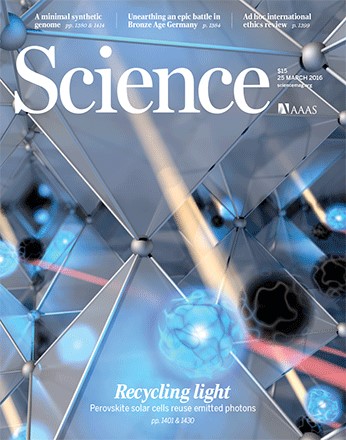Perovskites are one of the most exciting up-and-coming materials in the solar cell scene. These solid state materials are cheap to produce and have the most rapidly increasing efficiencies out of all solar cell materials; they are now competing with silicon, the most highly engineered of these. The reason behind hybrid lead halide perovskites’ high efficiencies remained a mystery until Luis Pazos-Outón (NanoDTC 2013) and coworkers revealed the inner working of how light interacts with this material.
When light hits a perovskite solar cell, it excites an electron, leaving behind a positive hole and creating a negatively charged site at the free electron. Both the hole and the electron are then able to diffuse to their respective electrodes. Opposite charges attract, favouring recombination over diffusion. If light can be absorbed, it is then necessary that it can be emitted, in a process known as radiative recombination. This light can be reabsorbed, creating another electron hole pair and generating a larger charge concentration. Radiative recombination is also the mechanism by which LEDs emit light.
The study published in Science showed that by concentrating a laser spot on a thin layer of perovskite, long range transport of reemitted light 50 micrometres away from the initial excitation region could be observed. This is a far greater distance than predicted, indicating radiative recombination is in operation. By quantifying the recycling effect the group predicts that in a standard cell the photon concentration is doubled in the crystal. Luis comments, “Recycling is a quality that materials like silicon simply don’t have. This effect concentrates a lot of charges within a very small volume. These are produced by a combination of incoming photons and those being made within the material itself, and that’s what enhances its energy efficiency.”

The study published in Science showed that by concentrating a laser spot on a thin layer of perovskite, long range transport of reemitted light 50 micrometres away from the initial excitation region could be observed. This is a far greater distance than predicted, indicating radiative recombination is in operation. By quantifying the recycling effect the group predicts that in a standard cell the photon concentration is doubled in the crystal. Luis comments, “Recycling is a quality that materials like silicon simply don’t have. This effect concentrates a lot of light within a very small volume. These are produced by a combination of incoming photons and those being made within the material itself, and that’s what enhances its energy efficiency.”
Pazos-Outón, Luis M., et al. “Photon recycling in lead iodide perovskite solar cells.” Science 351.6280 (2016): 1430-1433.

